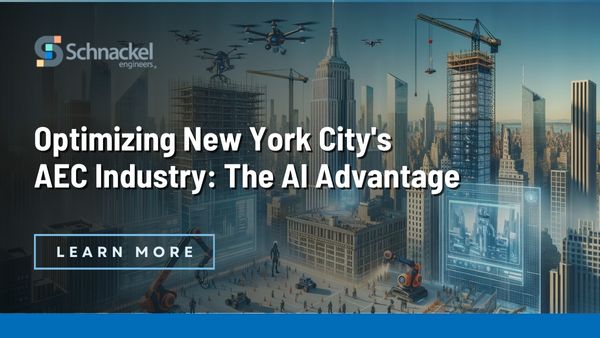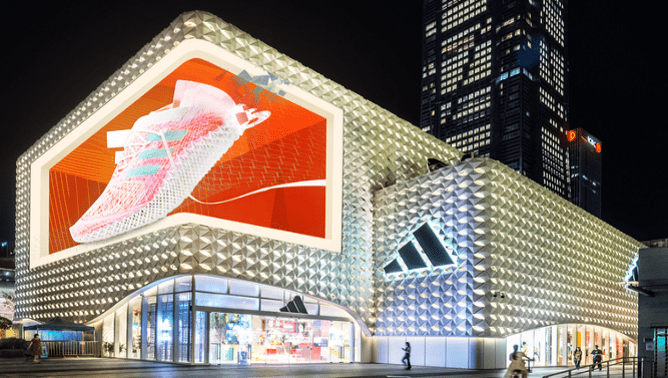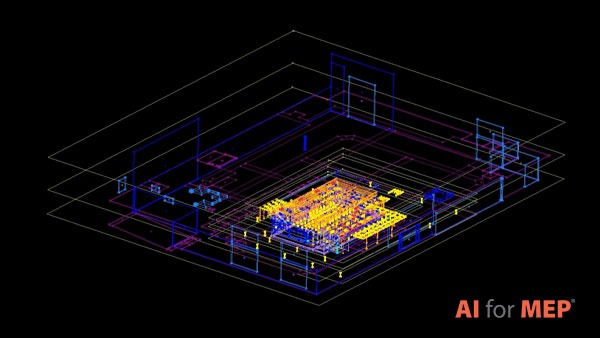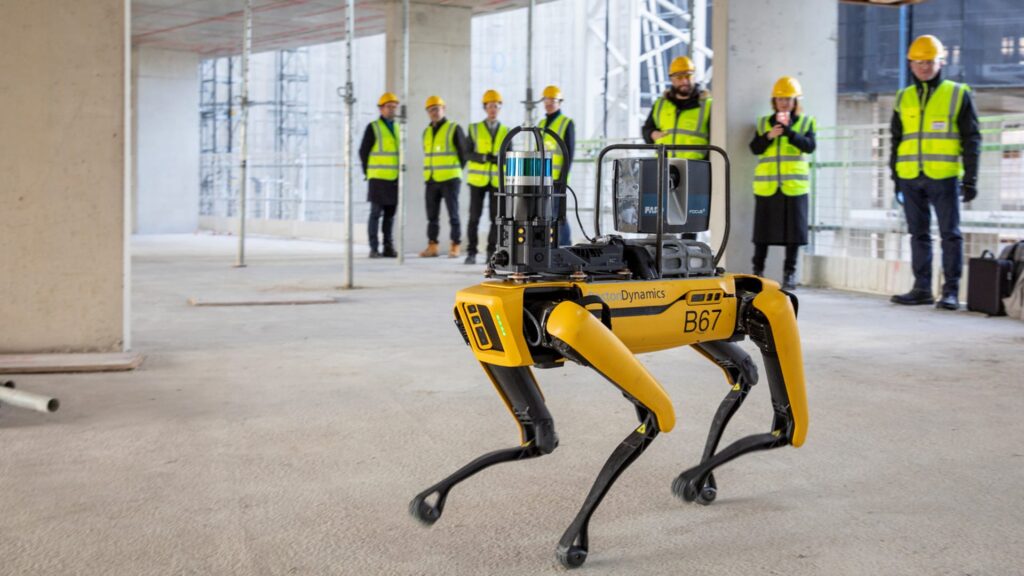Optimizing New York City’s AEC Industry: The AI Advantage

Optimizing New York City’s AEC Industry is crucial for maintaining its iconic skyline and driving urban development. However, this dynamic industry faces numerous challenges, such as inflation, supply chain disruptions, labor shortages, and a reluctance to embrace new technologies. These obstacles can impact the efficiency, safety, and cost-effectiveness of construction projects. Amidst these challenges, Artificial Intelligence (AI) emerges as a powerful tool with the potential to revolutionize the AEC industry. By harnessing AI for tasks like design optimization or project management, New York City’s AEC sector can overcome these hurdles and lead the way in modern urban development.
Common Challenges in the AEC Sector
The AEC(Architectural, Engineering, and Construction) sector is no stranger to challenges. Inflation and high interest rates have been a persistent issue, driving up the costs of materials and labor, which in turn affects project budgets. Supply chain disruptions, often due to global events or trade issues, lead to delays and increased costs. Labor shortages, a result of a dwindling skilled workforce, further exacerbates project timelines, budgets, and quality. Additionally, there’s a noticeable reluctance within the industry to adopt new technologies, with many preferring to stick to traditional methods or “the way we have always done it”. This resistance to change hinders innovation and efficiency.
The Rise of AI in Various Industries
Artificial Intelligence has already made a significant impact in various industries, demonstrating its potential to transform operations and outcomes. In healthcare, AI is used for predictive analytics, personalized medicine, and streamlining administrative tasks. The finance sector leverages AI for fraud detection, risk management, and automated trading. In IT, AI enhances cybersecurity and data analysis. Manufacturing benefits from AI through improved production efficiency and quality control.
These industry breakthroughs not only affirm AI’s transformative capabilities but also build a trust in its applicability across diverse fields. This growing confidence in AI sets a promising backdrop for its integration into more traditionally conservative sectors like the Architecture, Engineering, and Construction (AEC) industry. Despite a slower start in digital adoption, the AEC sector is on the cusp of a technological revolution, with AI at the forefront.
The growing interest in AI within the AEC industry marks a significant shift, indicating the sector’s readiness to use AI for addressing complex challenges. From improving project management to transforming design and increasing onsite safety, AI’s potential uses in the AEC sector are wide-ranging.
As we move to the next section, we will explore the specific AI technologies that are making a significant impact within the AEC industry. This exploration will show how AI is not just a tool for improving operations but a transformative force that is reshaping the fields of design, construction, and urban planning, leading to a new era of smart, sustainable, and efficient urban development.
Application of AI Tools in the AEC Industry
AI’s entry into the AEC industry is characterized by innovative applications that tackle specific challenges:
AI in Architectural Design
In architectural design, AI is revolutionizing the way architects approach their projects, offering innovative solutions that enhance both the creative and practical aspects of design.
AI-powered tools, such as 3D imaging, are accelerating the creation and refinement of complex models, enabling architects to quickly develop intricate façades and structures with precision. This technology not only enhances the speed and accuracy of the design process but also allows for greater experimentation and innovation.

by Adidas Brand Center – Shenzhen, China
Design ideation is another area where AI is making a significant impact in architectural design. By analyzing patterns, trends, and historical data, AI assists architects in generating innovative design concepts, pushing the boundaries of creativity. AI-powered image generation tools, like Midjourney, exemplify this by enabling architects to explore new design options quickly and efficiently. By entering specific prompts, architects can leverage AI to create multiple iterations of building designs, breaking away from traditional approaches and generating fresh ideas.
Moreover, in space planning, AI’s capabilities are invaluable, offering sophisticated insights to ensure floor plans are both aesthetically pleasing and operationally efficient. This technology considers the day-to-day functional needs and spatial relationships, aiming to support the operational effectiveness of the tenant’s business. For instance, qbiq, an AI software designed for efficient office planning, offers architects three ‘test fit’ options, each with analytical furniture layouts and 3D virtual tours, accompanied by a performance analysis report, to optimize the design process.
Furthermore, AI-driven tools are enabling architects to address sustainability challenges more effectively. By analyzing environmental data and simulating building performance, AI helps in designing energy-efficient buildings that reduce carbon footprints and promote environmental stewardship.
Overall, the integration of AI in architectural design is transforming the industry, making it possible to achieve higher levels of innovation, efficiency, and sustainability. As AI technology continues to evolve, it is poised to unlock even more possibilities in the realm of architectural design, shaping the future of our built environment.
AI in MEP Engineering Design
AI is transforming MEP engineering, streamlining complex processes, and enhancing precision and efficiency. AI serves as a powerful analytical engine, quickly navigating through numerous design solutions to identify the most optimized approaches, while ensuring compliance with stringent regulations.
AI-driven design automation software, such as AI for MEP®, revolutionizes how MEP systems are conceptualized, significantly reducing design time and construction costs, while improving accuracy and compliance. This technology enables rapid iteration of design solutions, optimizing systems for energy efficiency, cost, and performance.

AI for MEP® by Schnackel Engineers
AI also plays a crucial role in predictive maintenance within MEP systems. By continuously analyzing data from sensors and IoT devices, AI can predict system failures before they occur, schedule timely maintenance, and suggest improvements for future operations, leading to reduced downtime, lower maintenance costs, improved energy efficiency, and longer system lifespans.
In summary, AI is a transformative force in MEP engineering, offering robust solutions that carry projects from the drawing board to completion with greater speed, accuracy, and innovation. As New York City continues to grow, embracing AI in MEP design will be crucial for constructing buildings that are efficient, sustainable, and future-proof.
AI in Construction
In the construction phase, AI is dramatically reshaping efficiency, safety, and quality control. Factory based, automated modular construction techniques result in improved quality, quicker construction, and reduced cost. Robotics and automation, featuring automated surveying and grading equipment, brick-laying robots, and concrete printing machines, are becoming more common on job sites, reducing manual labor, while enhancing precision and safety. These innovations not only speed up construction but also open up new possibilities for complex structures that were once too costly or challenging to build.

In project management, AI-driven tools are optimizing construction scheduling, ensuring projects stay on track and within budget.
Quality control is another area where AI excels, with automated systems monitoring the work for adherence to the design documents, industry standards, and construction specifications.
Job site safety is a top priority, and AI is instrumental in monitoring work environments to identify potential hazards, and safety policy violations, thereby preventing accidents and ensuring the well-being of workers.
Through these innovations, AI is not just an auxiliary tool but a central component in modern construction practices, driving the industry toward a future where projects are safer, more efficient, and of higher quality.
Don’t Fear AI – Embrace It!
There’s a common apprehension toward AI in any industry, often rooted in concerns about job displacement and fear of the unknown. However, AI’s purpose is not to replace human expertise, but rather to augment it by eliminating monotonous tasks. By automating routine tasks, AI allows professionals to concentrate on the more strategic and creative aspects of their work.
Embracing AI technology is about embracing a future of greater efficiency, accuracy, and innovation. It’s time to see AI as an ally, not a threat, in building a smarter, more sustainable urban environment.
Adopting Artificial Intelligence (AI) is becoming essential for optimizing New York City’s AEC industry. AI’s impact on architectural design, MEP engineering, and construction is significant, enhancing efficiency, safety, and sustainability. As new AI technology evolves, it is increasingly shaping the future of urban development and establishing new benchmarks for the industry.
However, not embracing AI can lead to missed opportunities for innovation and lost competitive advantage, leaving firms behind in an increasingly technology-driven market. The future of AI in the AEC industry is promising, with potential for even greater advancements in automation, data analysis, and design innovation. This continued evolution will further revolutionize the way buildings are designed, constructed, and maintained.
At Schnackel Engineers, we’re harnessing AI to optimize your projects. Our experienced MEP/FP engineers in our New York office, equipped with the firm’s proprietary AI for MEP® software, are ready to help you leverage the benefits of AI, ensuring your projects are completed with greater speed, accuracy, and quality. Contact us to discover how we can assist in optimizing your projects with AI for a more successful outcome.
Comments